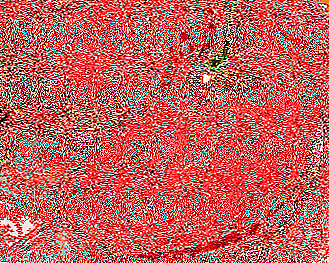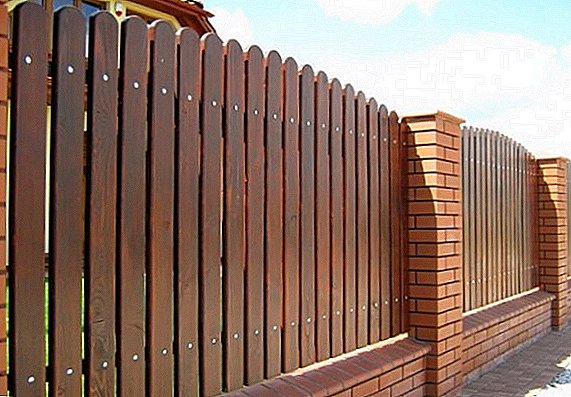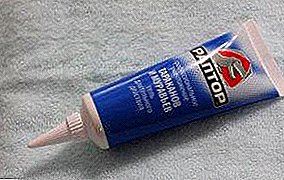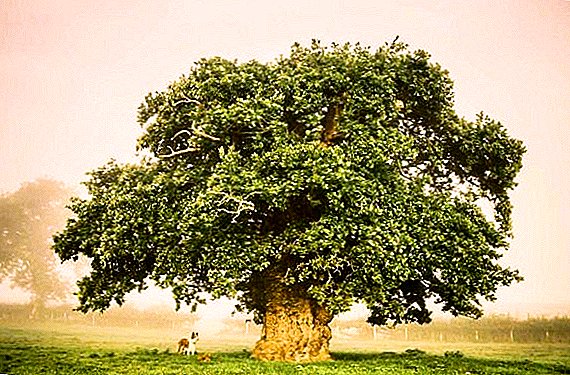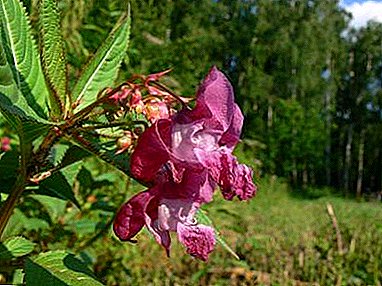
The people call him touchy. In the conditions of cultural floriculture ferrous balsam is intended for cultivation in the garden.
What is this flower? Where can I plant and how to land? How to care for a plant? What conditions need to provide ferrous balsamic?
This and much more will be discussed in this article. Therefore, if you are interested in this plant, then be sure to read this material. It also tells about how pests and diseases are affected by such balsam and how to deal with them.
Botanical description and history
Impatiens refers to annuals. Stalk her:
- fat;
- knotted;
- juicy;
- strongly branchy.
The flower grows up to 2 m. Egg-lanceolate leaves with a length of 6 to 12 cm have jagged edges. In the upper part of the stem, they are collected into beaters of 3 pieces. At the base of the leaf there are two stalked glands of dark red color. The root of the balsam is glandular.
Large, 3-3.5 cm long flowers stand on long peduncles. Their color is most often wine-red, but it is pink and white. The fruit is a sharp, obovate box on top, in which are small brown-black seeds.
Homeland balsam ferruginous are Himalayas. The flower was introduced as an ornamental plant in the 19th century. He prefers to grow in moist shady places, along the shores of lakes and rivers.
Most often it can be found in Asia and Africa, some species - Europe and America.
Description of appearance and features
 Ferrous balsam in gardening valued for its ornamental flowers. The plant turns out even more beautiful due to the fact that quite large inflorescences are combined into decorative brushes. Flowers smell delicate and subtle. On this smell many insects fly, which pollinate them. Therefore, glandular balsam refers to honey.
Ferrous balsam in gardening valued for its ornamental flowers. The plant turns out even more beautiful due to the fact that quite large inflorescences are combined into decorative brushes. Flowers smell delicate and subtle. On this smell many insects fly, which pollinate them. Therefore, glandular balsam refers to honey.
A touchstone flower has a curious feature, which is that when it blooms, drops of sweetish juice appear behind the leaves. They evaporate to form sugar crystals. It attracts ants.
Ferrous balsam is the largest of the balsamic family. The plant is not intended for indoor floriculture. The flower blooms from July to the arrival of the first cold weather.
He was called a touchy because of his particular way of spreading seeds. The fruit in the form of a juicy box during its touch upon ripening unexpectedly bursts. At the same time, the leaves immediately twist inward, and the seeds scatter in all directions.
This happens because the inner rather succulent tissues grow and extend the outer shell. The shell is not able to withstand such a strong pressure, sometimes it shrinks even from a light touch and twists the leaf of the box.
Ferrous balsamine can be decorated:
- flower beds;
- rabatki;
- curbs.
Where and how to plant a wild plant?
In order for this ornamental plant to grow well and delight you with your flowers, you need to choose the right area for it and do not forget to care for it.
Lighting and location
Ferrous balsam is a thermophilic plant, which limits the possibility of its use in landscape design. It is not suitable as an early spring decoration.
Important! When planting several bushes at once, it is necessary for the plants to be at a distance of 25 cm from each other. The fact is that an adult flower becomes quite tall.
The plant needs good lighting, diffused light. They are harmful to him:
- direct sunlight;
- drafts;
- wind.
In order for a flower to grow well and develop it needs a lot of space, it does not tolerate density. If too many plants are planted in one place, then the nutrients in the soil will not be enough for everyone. When thickening landings balsam will be undersized, and also possible to stop its flowering.
Soil requirements
 Ferrous balsam grows well in soil:
Ferrous balsam grows well in soil:
- loose;
- slightly acidic;
- breathable.
You can make this nutrient substrate yourself by mixing:
- peat crumb;
- perlite;
- sand medium fraction.
The flower has poorly developed and not very long roots, so a shallow pot will suit it.
How to care?
Although the humidity is not the most important for the growth of the glandular balsam, after all, with too dry air, its lower leaves begin to fall off. This flower needs a lot of water. However, in winter, with its excess, it may rot.
During the growing season, the flower needs nutrientsthat come to him when fertilizing fertilizers. Touching should be fertilized 1 time in 10 days. At that time, when the buds will form and during the flowering nitrogen fertilizers cannot be used, it is necessary to feed them with phosphorus-potassium fertilizers. From autumn to spring balsamine fermentation is not necessary, and you do not need to feed newly transplanted and sick flowers.
A young glandular balsam wraps the pot in a short time, so it is transplanted several times a year. Transplanting should be done quickly, the root system should not dry out.
To trim the appearance of the flower will help pruning. The procedure is performed in the spring. It is necessary to cut very long branches. This is not done immediately, but gradually. In order for the bush to become more branchy, pinch the tops of the shoots.
If necessary, ferrous balsam is allowed to repot even when it blooms.
Common diseases and pests
For ferrous balsam, the greatest danger is the low temperature outside. The flower will die even during small frosts and temperatures below +5 ° C. The plant is not insured against such diseases as:
- mosaic;
- gray rot;
- bronze foliage;
- powdery mildew.
There are also pests that are dangerous for a balsam, these are:
- aphid;
- spider mite;
- whitefly.
It is possible to get rid of them with the help of insecticides.
Breeding features
 Propagation of the glandular balsam is a rather easy process.. The procedure can be done by cuttings and seeds. In spring or autumn, cuttings that are planted directly into the ground should be cut from a healthy adult plant. The flower is well rooted.
Propagation of the glandular balsam is a rather easy process.. The procedure can be done by cuttings and seeds. In spring or autumn, cuttings that are planted directly into the ground should be cut from a healthy adult plant. The flower is well rooted.
With this method of propagation, growers with experience are advised to plant several cuttings in one pot. Thanks to this simple reception, the flower will turn out to be lush and beautiful.
During their development and growth by pinching a bush, you can give the necessary shape. During the growing season, this procedure is performed 2-3 times. In the bush leave strong shoots with flowers in the amount of 3-4 pieces, and all the rest are cut.
The seed breeding procedure starts in January:
- It is necessary to prepare a container where a light soil substrate is poured, which includes: 1 part of leaf and humus soil, 0.5 parts of sand.
- Seeds are sown on the surface and slightly sprinkled with soil. Then the container should be covered with a transparent film and put in a warm place.
- After seed germination, additional lighting should be arranged.
- Watering the seedlings must be regular, you can not pour the soil, and also to prevent it from drying out.
Glandular balsam is a fairly unpretentious plant. This makes it very popular. Flower gardeners and landscape designers love for the fact that it looks great in both single and collective plantings.
One of the wonderful representatives of the vast number of the Balsamic family is



